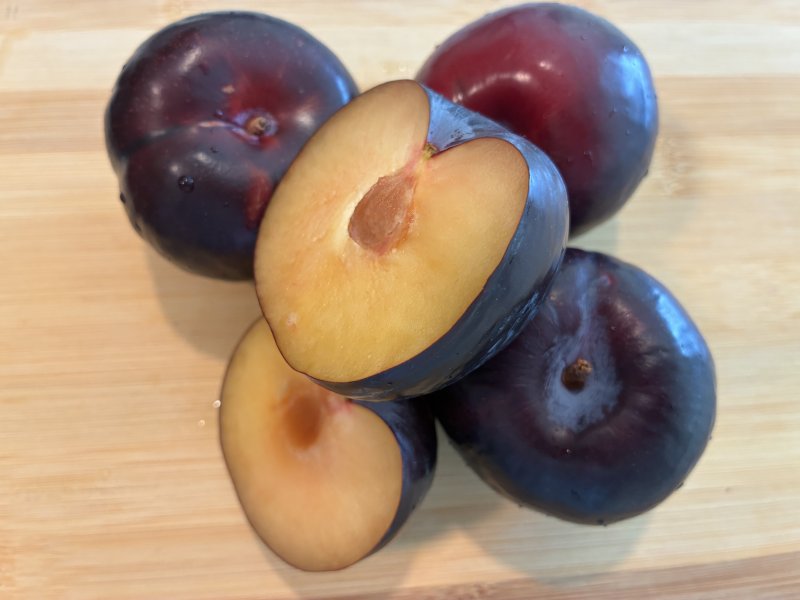Plums get a thumbs-up for all sorts of recipes
On a recent visit to Fresh Market (I was craving stuffed grape leaves), I walked through the produce aisle and noticed a lovely display for a variety of stone fruits, also known as drupes. These are the names given to fruits whose flesh forms around a central pit. The most familiar of these are peaches, apricots and plums. They all belong to the botanical genus Prunus in the Rosaceae family. It surprised me to learn that plums and cherries are close cousins, differing primarily in size.
According to food historian Alan Davidson, the word “plum” hasn’t been crisply defined and was often misused. In the Middle Ages, any dried fruit was called a plum, including raisins (hence plum pudding, which is made with lots of raisins). Davidson shares an interesting side note about the story of “Little Jack Horner” eating his mincemeat pie. When he “stuck in his thumb and pulled out a plum,” all he likely had was a raisin.
Many of our fruits and vegetables had origins in ancient Rome and Greece, and the earliest mention of plums comes from Pliny, a first century Roman author and scientist. During medieval times in England, Chaucer wrote about monastery gardens growing “ploumes.” In the following centuries, several European varieties of plums emerged and were given specific names, including Damson, Greengage, Early Rivers and Mirabelle.
Native Americans were aware of indigenous wild plums found along the northeastern coastline. Still common in our area today, these are known as “beach plums,” used for jams and jellies. Plums called “sloe” or blackthorn are used to make sloe gin and flavorings. The southeastern “Chickasaw plum” and Canadian black plums eventually mixed with imported European plums brought to this country by settlers.
Today, there are more than 300 species of plums, and a few types of them are commonly found at the market. They range in color from apple-red to dappled yellow to bluish-purple, with flesh in colors from yellow to dark red. They can be sorted into two distinct types: European and Japanese. European plums are also called prune plums, because they are primarily used in their dried form or for baking. They have thick skins and dense yellow flesh with a high sugar content.
Japanese plums have been bred to be eaten fresh out of hand. They come in a variety of colors and shapes, from round to oblong to heart-shaped. They have thin skins and flesh that clings to the stone, making them messy to halve or pit. When choosing plums, look for smooth, wrinkle-free, blemish-free skin. Select those that are firm and heavy for their size. To test their ripeness, gently press the flower-end (opposite the stem) which should have a little give.
If you need to ripen plums, leave them in a paper bag for a day or two at room temperature. If they get too soft, freeze them for a delicious smoothie. In order to freeze plums, halve them and remove the pit. Place them cut-side up on a baking sheet and place them in the freezer. Transfer them to a plastic bag, remove the air and seal. They’ll keep in your freezer for up to six months.
I’ve included two recipes for the plums you’ll find at the market through the end of the month, including the Moonlight variety of plums in the photo. Their name is from the California-based grower, which also offers peaches and apricots. The plum tart is lovely for an elegant dessert, and the plum sorbet is easy to assemble. Grand Marnier (or another liqueur) will prevent ice crystals as the sorbet freezes and add a nice flavor note.
Plum Tart
Preheat oven to 375 F. Coat the inside of a tart pan with nonstick cooking spray; set aside. Place the butter in the bowl of a food processor; add the dry ingredients and pulse into uniform crumbs. Combine the egg yolk, egg, almond extract, lemon zest and milk in a small bowl; whisk to combine. Add the liquid to the flour mixture and stir into a thick dough. Using a spatula or your hands (dusted with flour), spread the dough evenly in the bottom and up the sides of the pan. Slice the plums into a bowl, cutting them into 1/2-inch-thick wedges. Arrange the plums on the dough, overlapping slightly. Pour the melted butter over the plums. Combine the sugar and cinnamon, and dust over plums. Bake until the plums are softened, about 40 minutes.
Plum Sorbet*
Place sliced plums, sugar, lemon juice and salt in a blender or food processor. Purée until very smooth. Strain mixture through a fine mesh sieve to catch and discard any large pieces of skin. Mix in the Grand Marnier and transfer mixture to an ice cream machine. Churn until frozen, about 25 minutes. Serve immediately or place in an airtight container in the freezer. Yield: 1 quart. *Adapted from simplyrecipes.com.

























































